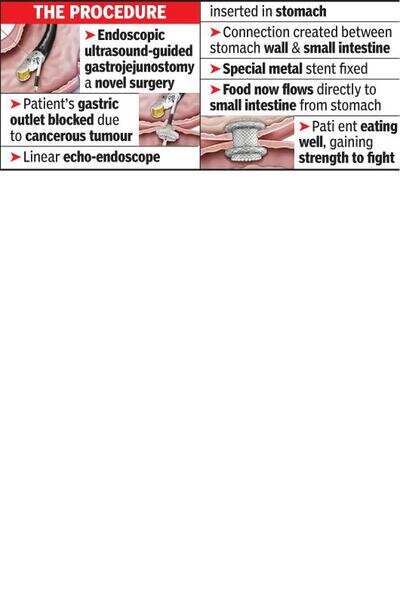- News
- City News
- nagpur News
- Stent links stomach with small intestine to bypass tumour
Stent links stomach with small intestine to bypass tumour

Nagpur: A 60-year-old woman with a cancerous tumour in her gastric outlet was relieved from difficulty in food intake after doctors used a stent to connect her stomach with small intestine, bypassing the gastric outlet which was blocked by the tumour.
Tumour in the stomach is a common cause for gastric cancer. The patient is unable to eat as the tumour obstructs food passage from the stomach to the intestine. This leads to nutritional issues and aggravates the suffering of cancer patients.
As the surgery was minimally invasive, the patient was allowed to eat just four hours after the procedure, and she went home the very next day. Over the next seven days, she started having normal food and gained weight and strength to fight cancer. City gastroenterologist Dr Amit Agrawal, who performed this surgery, claimed it was the first such procedure in Central India.
Dr Agrawal used a novel technique of linear echoendoscope and inserted a specially designed metallic stent. This procedure requires an advanced endoscope called Endoscopic Ultrasound, which is only available at a select few hospitals in the country.
The surgeon said this is a unique procedure that allows patients with stomach cancer to eat food for the rest of their lives without any recurrence. “In this procedure, a puncture is made directly from the stomach into the small intestine and the stent is placed,” said Dr Agrawal.
The cancer patient was being treated by oncologist Dr Sushil Mandhaniya, who referred her to Dr Agrawal.
There are two options to resolve such issues. The first is surgery to remove the tumour, which was quite difficult for this patient. So, the second option — planting a metallic stent (pipe) through the tumour mass which allows the patient to eat food — was planned.
“In January, we fixed a stent through the tumour. But the stent was blocked in a few months as a cancerous tumour grew inside it. To solve this problem, we decided to go for a novel technique of joining the stomach with the small intestine, bypassing the tumour with the help of a specially designed metallic stent,” said Dr Agrawal.
The procedure carried some risk, but the patient was ready for it, he said.
Tumour in the stomach is a common cause for gastric cancer. The patient is unable to eat as the tumour obstructs food passage from the stomach to the intestine. This leads to nutritional issues and aggravates the suffering of cancer patients.
As the surgery was minimally invasive, the patient was allowed to eat just four hours after the procedure, and she went home the very next day. Over the next seven days, she started having normal food and gained weight and strength to fight cancer. City gastroenterologist Dr Amit Agrawal, who performed this surgery, claimed it was the first such procedure in Central India.
Dr Agrawal used a novel technique of linear echoendoscope and inserted a specially designed metallic stent. This procedure requires an advanced endoscope called Endoscopic Ultrasound, which is only available at a select few hospitals in the country.
The surgeon said this is a unique procedure that allows patients with stomach cancer to eat food for the rest of their lives without any recurrence. “In this procedure, a puncture is made directly from the stomach into the small intestine and the stent is placed,” said Dr Agrawal.
The cancer patient was being treated by oncologist Dr Sushil Mandhaniya, who referred her to Dr Agrawal.
There are two options to resolve such issues. The first is surgery to remove the tumour, which was quite difficult for this patient. So, the second option — planting a metallic stent (pipe) through the tumour mass which allows the patient to eat food — was planned.
“In January, we fixed a stent through the tumour. But the stent was blocked in a few months as a cancerous tumour grew inside it. To solve this problem, we decided to go for a novel technique of joining the stomach with the small intestine, bypassing the tumour with the help of a specially designed metallic stent,” said Dr Agrawal.
The procedure carried some risk, but the patient was ready for it, he said.
FOLLOW US ON SOCIAL MEDIA
FacebookTwitterInstagram
Looking for Something?

Start a Conversation
end of article
Visual Stories
Quick Links
Assam FloodDelhi TemperatureChennai WeatherBangalore TemperatureCovid vaccination centres in DelhiCoronavirus in DelhiRTPCR test in GurgaonHyderabad RainPollution level in BangaloreDelhi SmogDelhi TemperatureNoida AQIGurgaon AQI todayFire in MumbaiMumbai RainsCovid 19 RT PCR Test in NoidaDelhi AQI todaySrinagar encounter

